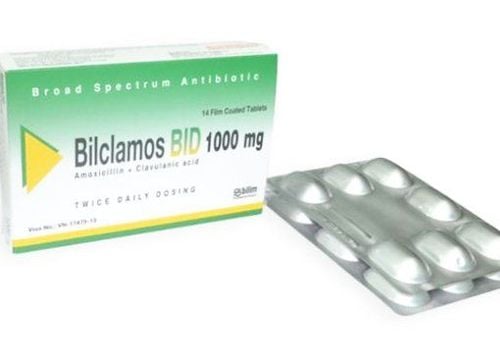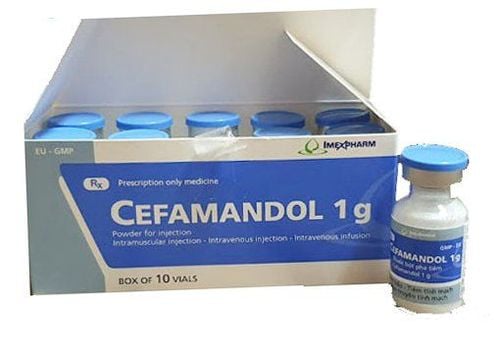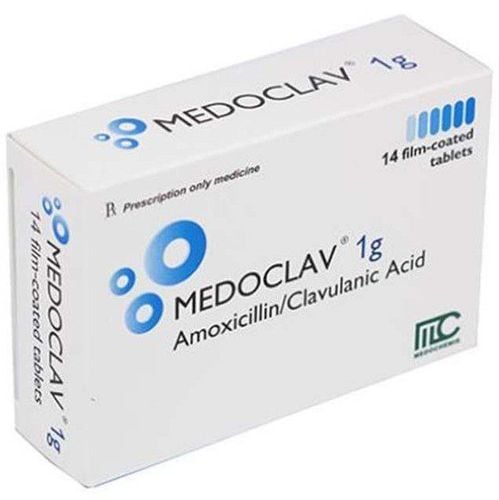This is an automatically translated article.
Quincef 125 is an antibiotic indicated for the treatment of infections caused by susceptible bacteria such as: upper and lower respiratory tract infections, skin and soft tissue infections, urogenital tract. To ensure the effectiveness of treatment and avoid side effects, users need to strictly follow the instructions of the doctor, professional pharmacist.
1. What is Quincef 125?
What is Quincef 125? Quincef 125 is a drug with the main active ingredient being Cefuroxime, the drug is prepared in the form of a powder for oral administration, each package contains Cefuroxime axetil equivalent to Cefuroxime 125mg. Cefuroxime axetil is a precursor that has no antibacterial effect, hydrolyzed in the body under the action of esterase enzyme to Cefuroxime.Cefuroxime is a Cephalosporin antibiotic, semi-synthetic with a broad spectrum of second-generation antibacterial activity. Cefuroxime binds to essential proteins that inhibit bacterial cell wall synthesis, and has a killing effect on bacteria during division and growth. develop. Cefuroxime binds to penicillin-binding proteins, which are proteins involved in the composition of bacterial cell membranes, acting as enzymes that catalyze the final stage of cell wall synthesis. Leads to the synthesized cell wall being weakened and unstable under the influence of osmotic pressure. The binding affinity of Cefuroxime to penicillin-binding proteins of different types determines the spectrum of action of the drug.
Cefuroxime antibacterial spectrum:
Cefuroxim has better in vitro activity against Gram-negative bacteria than 1st generation Cephalosporin antibiotics. However, the spectrum of activity on Gram-negative bacteria is narrower than 3rd generation Cephalosporin antibiotics.
Cefuroxime It is active against aerobic and anaerobic Gram-positive and Gram-negative cocci, including penicillinase-producing Staphylococcus strains. Besides, Cefuroxime has activity against Gram-negative intestinal bacteria. In addition, Cefuroxime is active against the following bacteria:
Gram-negative aerobic: Haemophilus influenzae (including ampicillin-resistant strains), Neisseria gonorrheae, Escherichia coli, Klebsiella, Proteus, Moraxella catarrhalis. Gram-positive aerobic: Staphylococcus aureus, Staph. epidermidis, Group B Streptococcus, Streptococcus pneumoniae. Anaerobic: Gram-positive and Gram-negative cocci (including Peptococcus and Peptostreptococcus species), Gram-positive bacilli (including Clostridium species), Gram-negative bacilli (including Bacteroides and Fusobacterium species)
2. Indications and contraindications of Quincef 125
2.1. Indications Quincef is indicated in the treatment of infections caused by susceptible bacteria:
Upper respiratory tract: Middle ear infections (caused by H. influenzae, S. pneumoniae, M. catarrhalis including beta-lactamase producing strains) or by S. pyogenes), sinusitis, tonsillitis (due to S. pneumoniae, H. influenzae) and pharyngitis (due to S. pyogenes, group A beta-hemolytic streptococcus). Lower respiratory tract: Pneumonia, acute bronchitis and exacerbations of chronic bronchitis (due to S. pneumoniae, H. Influenzae). Genitourinary tract: cystitis, urethritis and pyelonephritis. Skin and soft tissue: boils, pyoderma, impetigo. Gonorrhea: cervicitis, uncomplicated acute urethritis caused by gonorrhea. Cefuroxime axetil is indicated in the treatment of early Lyme disease. Before and during the treatment of infections, bacterial cultures and antibiograms should be obtained. In addition, assess renal function when indicated.
2.2. Contraindications Quincef 125 is contraindicated in patients with a history of allergy or hypersensitivity reaction to Cefuroxime or Cephalosporin antibiotics.
3. How to take Quincef 125
3.1. Dosage of Quincef Patients should take Quincef 125 after meals to achieve optimal absorption. The duration of Quincef in treatment is from 5 to 10 days.
Adults
Infectious diseases: 250mg/time x 2 times/day. Urinary tract infections: 125mg/time x 2 times/day. Bronchitis and pneumonia: 500mg/time x 2 times/day. Children
Infectious diseases: 125mg/time x 2 times/day. Children 2 years and older with otitis media or severe infections: 250mg/time x 2 times/day. Patients with renal failure, on dialysis or the elderly do not need to adjust the dose if not more than 1g/day.
3.2. Overdosage with Quincef and its management Overdose of Quincef often causes nausea, vomiting, and diarrhea. In some cases, there may be an increase in neuromuscular excitability, convulsions, especially in patients with renal failure.
Management: Protect the respiratory tract and support ventilation, infusion. In the event of convulsions, the drug should be discontinued and anticonvulsant therapy instituted, if indicated. Supportive or symptomatic treatment is essential, hemodialysis can be used to remove drugs from the blood.
4. Undesirable effects when using Quincef 125
The rate of unwanted side effects that can be encountered when using Quincef is about 3%. Among them, diarrhea and skin rash are the most common side effects.
Some less common side effects when using Quincef are:
Systemic: anaphylaxis, Candida infection, fever. Blood: eosinophilia, leukopenia, positive Coombs test. Hemolytic anemia. Gastrointestinal: Nausea, vomiting. Pseudomembranous colitis. Liver: cholestatic jaundice; elevated liver enzymes, LDH, alkaline phosphatase and transient bilirubin levels. Skin: urticaria, pruritus, Stevens-Johnson syndrome, erythema multiforme, toxic epidermal necrolysis. Urogenital - genitourinary: interstitial nephritis, acute renal failure. Transient increase in blood urea and creatinine. Urinary tract infection, urethral pain or bleeding, difficulty urinating, vaginitis. Central nervous system: Convulsions, headache, agitation. Other parts: Joint pain. Stop using Quincef as soon as you experience unwanted effects and go to a medical facility for timely treatment. In the case of patients with severe allergies or hypersensitivity reactions, supportive treatment should be instituted.
5. Some notes when using Quincef 125
In the process of using Quincef 125, patients should note:
Before using Quincef, it is necessary to ask carefully the history of allergy, anaphylaxis to Cephalosporin, Penicillin or other drugs. The safety and effectiveness of cefuroxime axetil in children younger than 3 months of age have not been adequately studied. Cefuroxime rarely causes changes in renal function, however, renal function should be checked before treatment with Cefuroxime, especially in critically ill patients receiving the maximum dose of antibiotic. Caution should be exercised in patients receiving concomitant potent diuretics, due to possible adverse effects on renal function. An increased possibility of nephrotoxicity has been reported with the use of Cephalosporins and Aminoglycosides. Long-term use of Cefuroxime may result in the overgrowth of non-susceptible bacteria. Monitor the patient closely, stop using the drug if there is a serious superinfection during treatment. Clostridium difficile pseudomembranous colitis has been reported with the use of broad-spectrum antibiotics, so this diagnosis should be taken into account. Use caution when prescribing broad-spectrum antibiotics to people with gastrointestinal disease, especially colitis. Some Cephalosporin antibiotics (including Cefuroxime) have the ability to cause seizures. If convulsions occur, the drug should be discontinued and appropriate antiepileptic drugs used. Use caution when using Quincef when driving a vehicle or operating machinery. Pregnant women: There are no studies to fully evaluate the safety of Cefuroxime in pregnant women. Lactation: Cefuroxime may be excreted in human milk at low concentrations. The possibility of drug accumulation in the infant is possible, and the risk of adverse events in breastfed infants has not been fully evaluated at this time. Use the drug in this population after carefully weighing the risks and benefits. Besides, it is necessary to monitor children when using Cefuroxime antibiotics for mothers.
6. Drug interactions
Ranitidine with sodium bicarbonate: reduces the bioavailability of Cefuroxime axetil. Take Cefuroxime axetil at least 2 hours after taking an antacid or H2 blocker. Probenecid: High doses reduce the renal clearance of Cefuroxime, resulting in higher and more prolonged plasma concentrations. Aminoglycosides, potent diuretics (Frosemide): Concomitant use with Cefuroxime increases the possibility of nephrotoxicity. Oral contraceptives containing estrogen and progesterone: Cefuroxime axetil taken orally can affect the intestinal microflora, reduce the reabsorption of estrogen, and reduce the effect of female sex hormones. Quincef 125 is an antibiotic indicated for the treatment of infections caused by susceptible bacteria such as: infections of the upper and lower respiratory tract, skin and soft tissue, and urogenital tract. To ensure the effectiveness of treatment and avoid side effects, users need to strictly follow the instructions of the doctor, professional pharmacist.
Follow Vinmec International General Hospital website to get more health, nutrition and beauty information to protect the health of yourself and your loved ones in your family.
Please dial HOTLINE for more information or register for an appointment HERE. Download MyVinmec app to make appointments faster and to manage your bookings easily.













